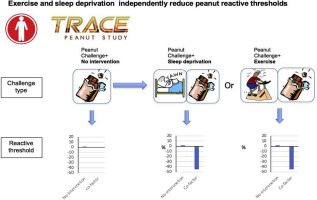当前位置:
X-MOL 学术
›
J. Allergy Clin. Immunol.
›
论文详情
Our official English website, www.x-mol.net, welcomes your
feedback! (Note: you will need to create a separate account there.)
Effect of sleep deprivation and exercise on reaction threshold in adults with peanut allergy: A randomized controlled study.
Journal of Allergy and Clinical Immunology ( IF 11.4 ) Pub Date : 2019-07-15 , DOI: 10.1016/j.jaci.2019.06.038 Shelley Dua 1 , Monica Ruiz-Garcia 2 , Simon Bond 3 , Stephen R Durham 4 , Ian Kimber 5 , Clare Mills 6 , Graham Roberts 7 , Isabel Skypala 8 , James Wason 9 , Pamela Ewan 10 , Robert Boyle 11 , Andrew Clark 1
Journal of Allergy and Clinical Immunology ( IF 11.4 ) Pub Date : 2019-07-15 , DOI: 10.1016/j.jaci.2019.06.038 Shelley Dua 1 , Monica Ruiz-Garcia 2 , Simon Bond 3 , Stephen R Durham 4 , Ian Kimber 5 , Clare Mills 6 , Graham Roberts 7 , Isabel Skypala 8 , James Wason 9 , Pamela Ewan 10 , Robert Boyle 11 , Andrew Clark 1
Affiliation

|
BACKGROUND
Peanut allergy causes severe and fatal reactions. Current food allergen labeling does not address these risks adequately against the burden of restricting food choice for allergic patients because of limited data on thresholds of reactivity and the influence of everyday factors.
OBJECTIVE
We estimated peanut threshold doses for a United Kingdom population with peanut allergy and examined the effect of sleep deprivation and exercise.
METHODS
In a crossover study, after blind challenge, participants with peanut allergy underwent 3 open peanut challenges in random order: with exercise after each dose, with sleep deprivation preceding challenge, and with no intervention. Primary outcome was the threshold dose triggering symptoms (in milligrams of protein). Primary analysis estimated the difference between the nonintervention challenge and each intervention in log threshold (as percentage change). Dose distributions were modeled, deriving eliciting doses in the population with peanut allergy.
RESULTS
Baseline challenges were performed in 126 participants, 100 were randomized, and 81 (mean age, 25 years) completed at least 1 further challenge. The mean threshold was 214 mg (SD, 330 mg) for nonintervention challenges, and this was reduced by 45% (95% CI, 21% to 61%; P = .001) and 45% (95% CI, 22% to 62%; P = .001) for exercise and sleep deprivation, respectively. Mean estimated eliciting doses for 1% of the population were 1.5 mg (95% CI, 0.8-2.5 mg) during nonintervention challenge (n = 81), 0.5 mg (95% CI, 0.2-0.8 mg) after sleep, and 0.3 mg (95% CI, 0.1-0.6 mg) after exercise.
CONCLUSION
Exercise and sleep deprivation each significantly reduce the threshold of reactivity in patients with peanut allergy, putting them at greater risk of a reaction. Adjusting reference doses using these data will improve allergen risk management and labeling to optimize protection of consumers with peanut allergy.
中文翻译:

剥夺睡眠和运动对花生过敏成人反应阈值的影响:一项随机对照研究。
背景技术花生过敏导致严重和致命的反应。由于反应性阈值和日常因素的影响的数据有限,当前的食物过敏原标签不能充分解决这些风险,无法应对过敏患者限制食物选择的负担。目的我们估算了患有花生过敏的英国人群的花生阈值剂量,并研究了睡眠剥夺和运动的影响。方法在一项交叉研究中,盲人挑战后,对花生过敏的参与者随机接受3次开放性花生挑战:每次服药后进行运动,挑战前睡眠剥夺,且无干预。主要结果是阈值剂量触发症状(以毫克蛋白质表示)。初步分析估计了非干预挑战与每次干预之间的对数阈值(以百分比变化)之间的差异。对剂量分布进行建模,得出花生过敏人群的诱发剂量。结果在126名参与者中进行了基线挑战,将100名患者进行了随机分组,有81名(平均年龄,25岁)完成了至少1次进一步的挑战。非干预性挑战的平均阈值为214 mg(SD,330 mg),分别降低了45%(95%CI,21%至61%; P = .001)和45%(95%CI,22%至90%) 62%; P = 0.001)分别代表运动和睡眠不足。在非干预性攻击(n = 81)期间,针对1%人口的平均估计诱发剂量为1.5 mg(95%CI,0.8-2.5 mg),睡眠后为0.5 mg(95%CI,0.2-0.8 mg)和0.3 mg (95%CI,0.1-0.6 mg)。结论运动和睡眠剥夺都显着降低了花生过敏患者的反应阈值,使他们有更大的反应风险。使用这些数据调整参考剂量将改善过敏原风险管理和标签,以优化对花生过敏的消费者的保护。
更新日期:2019-12-04
中文翻译:

剥夺睡眠和运动对花生过敏成人反应阈值的影响:一项随机对照研究。
背景技术花生过敏导致严重和致命的反应。由于反应性阈值和日常因素的影响的数据有限,当前的食物过敏原标签不能充分解决这些风险,无法应对过敏患者限制食物选择的负担。目的我们估算了患有花生过敏的英国人群的花生阈值剂量,并研究了睡眠剥夺和运动的影响。方法在一项交叉研究中,盲人挑战后,对花生过敏的参与者随机接受3次开放性花生挑战:每次服药后进行运动,挑战前睡眠剥夺,且无干预。主要结果是阈值剂量触发症状(以毫克蛋白质表示)。初步分析估计了非干预挑战与每次干预之间的对数阈值(以百分比变化)之间的差异。对剂量分布进行建模,得出花生过敏人群的诱发剂量。结果在126名参与者中进行了基线挑战,将100名患者进行了随机分组,有81名(平均年龄,25岁)完成了至少1次进一步的挑战。非干预性挑战的平均阈值为214 mg(SD,330 mg),分别降低了45%(95%CI,21%至61%; P = .001)和45%(95%CI,22%至90%) 62%; P = 0.001)分别代表运动和睡眠不足。在非干预性攻击(n = 81)期间,针对1%人口的平均估计诱发剂量为1.5 mg(95%CI,0.8-2.5 mg),睡眠后为0.5 mg(95%CI,0.2-0.8 mg)和0.3 mg (95%CI,0.1-0.6 mg)。结论运动和睡眠剥夺都显着降低了花生过敏患者的反应阈值,使他们有更大的反应风险。使用这些数据调整参考剂量将改善过敏原风险管理和标签,以优化对花生过敏的消费者的保护。











































 京公网安备 11010802027423号
京公网安备 11010802027423号